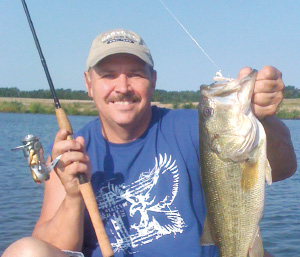
By Kenneth Keiser
April 13, 2011
Northeast News is excited to announce that Kenneth L. Kieser, a well-known outdoor writer, has joined our team as an outdoor columnist.
We will begin featuring his articles on our website.
About Kieser
Kieser, 57, is a veteran writer of 35 years with several thousand bylines in newspapers and magazines. His work, writing and photos have appeared in most of America’s top outdoor magazines and numerous newspapers.
Kieser has won numerous magazine and newspaper awards and was inducted into the National Fresh Water Fishing Hall of Fame in the Legendary Communicator 2010 class.
Kieser has written two novels, “Ride the Trail of Death,” and “Black Moon’s Revenge.”
• • • •
April brings warm rain, dogwood blooms and incredibly tasty morel mushrooms. Chances are this tasty gem has met your shadow during springtime walks in the woods. They are masters of concealment in dead leaves and under or around spring foliage.
The average hunter may find 10 and walk past 100. Morel hunting is an enjoyable challenge.
Missouri offers unlimited public access where filling a bread sack with morels is possible. You will likely have competition, so keep looking. No one can find them all. My first morel mushroom hunt happened 58 years ago with my mother. I was born the next day. She has never missed a mushroom season since.
Where to find morels: We start looking for morel mushrooms in late March or early April when woodlot plants are growing. Half-grown mayflowers are a good indicator of the required soil warmth when early morels start to pop up.
Dying elm trees produce a rotting root system that feeds morels. You may not find morels in the same spot after the roots are rotted away. Don’t limit your search to only elms. Check unlikely areas. The darn things could pop up anywhere. Apple trees are good, too. Constantly rotting fruit can produce morel mushrooms.
Areas with good leaf matting, typically under trees that drop their leaves and bark earlier in the fall and have longer to decay, consistently produce. Light-colored barked trees like birch, sycamore and cottonwoods are good examples, while dying elm trees may only produce morels for a year or two.
Watch the Weather Channel: Morel mushrooms are temperature sensitive. Early-season hunters should start by checking southern hillsides and creek bottoms that are open to sunlight. Warming trends make eastern areas productive. Northern spots are best when air temperatures heat up at the end of morel season.
A combination of warm days and nights with adequate spring rains is best. The perfect morel environment is wet conditions and temperatures between 60 and 80 degrees.
Morels do not grow by the sun, lacking chlorophyll, the chemical that absorbs sunlight as energy to reproduce. They start popping up at dusk and grow through the night.
When the sun comes up, morels dry out and release their spores, the seeds for new morels. Some catch a wind current and float to meet another spore from another morel to create more, occasionally making them grow in unexpected places.
Two neat tricks for more morels: Experienced hunters use mesh bags to gather morels. A mesh bag allows spores to release for future mushrooms. We use the same bag over and over, season after season without washing.
Spores that may create new morels come from the mushroom’s head. The ridged pattern of the bag helps release the spores. Some stay in the mesh and release later. Always cut or pinch morel mushrooms off at the bottom. Leaving the roots often helps produce new mushrooms when conditions are correct.
Equipment needed for more morel mushroom hunting: You will need a good pair of walking boots, light colored clothing in case early ticks make an appearance, a mesh bag, a good walking stick and your best pair of eyes. Then, walk slowly and search.
When the first morel is found, kneel down and look a little longer. My father always said: “Where you find one, you will find two or more.” He was always right.
• • • •
More tips
•Wheelchair or disabled morel hunters are limited to paved paths at wildlife areas. Morels can occasionally be spotted from these trails, sometimes with binoculars.
•Contact the Missouri Mycological Society’s Brad Bomanc at (636) 225-0555 for information about seminars or more information on morel mushrooms and other species.
The Missouri Department of Conservation Nature Centers have free literature and experts on hand to give advice on finding morels or places to hunt and examine what you found. You can find a nature center close to you by calling: (573) 751-4115.
•John and Theresa Maybrier of Team Morel in Parkville, Mo., hold mushroom seminars. Their book, “Enjoy…The Sport of Morel Hunting,” is an excellent guide that shows how and where to look.
















